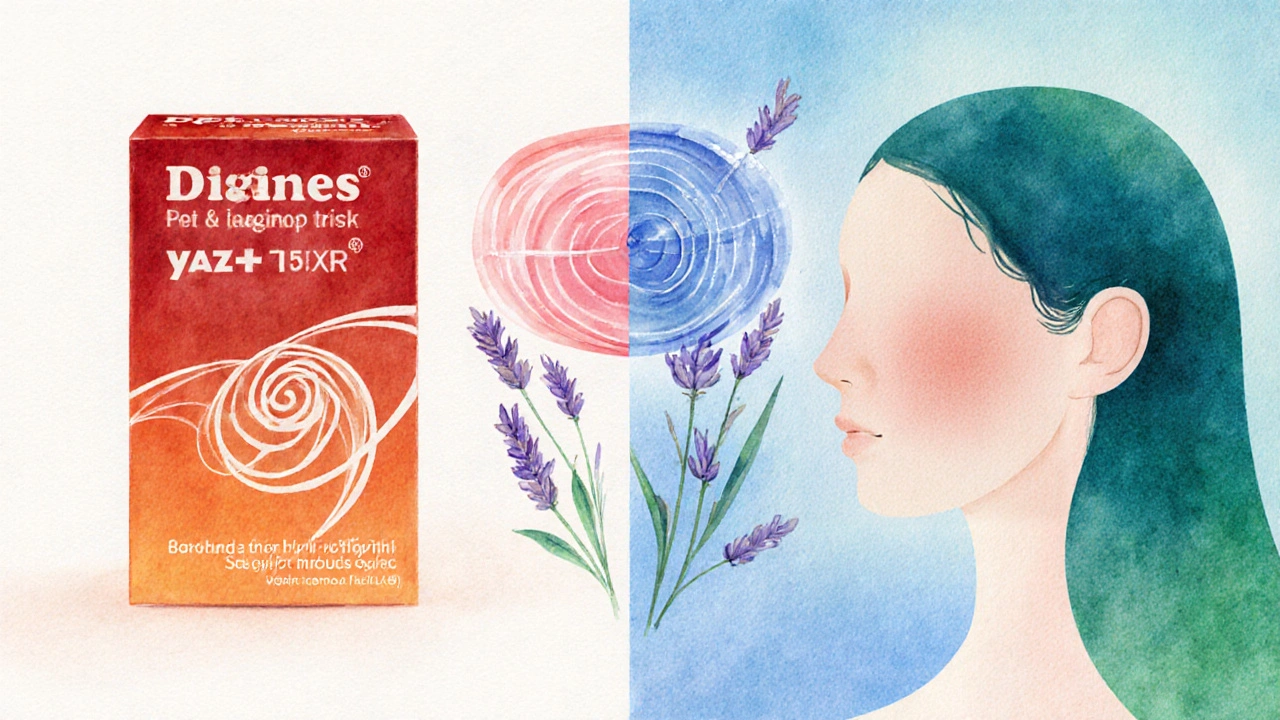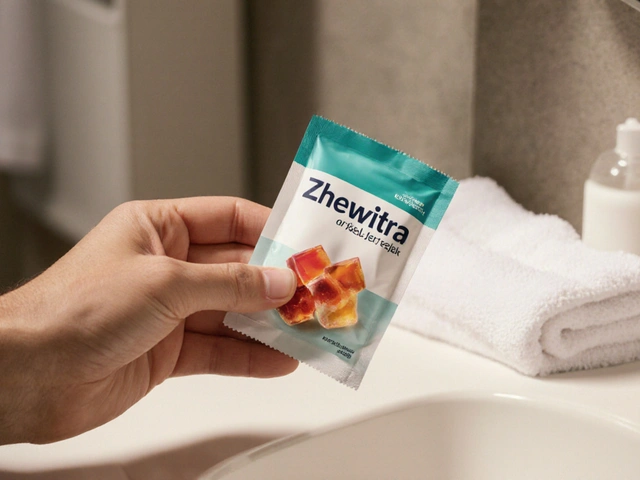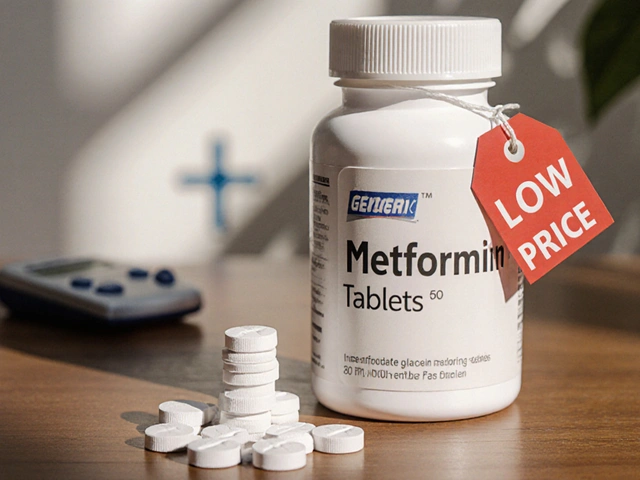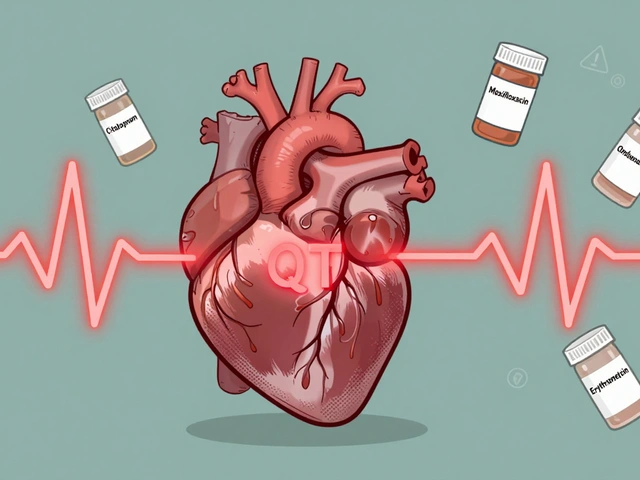
Birth Control Pill Comparison Tool
Find Your Best Match
Select your primary health concern and risk factors to get personalized recommendations between Diane 35 and its alternatives.
Recommended Pill:
Why This Choice:
Pill Comparison Details
Alternative Pills
Quick Takeaways
- Diane 35 combines a high‑potency anti‑androgen with 35µg ethinyl estradiol, making it a strong option for acne and PCOS.
- Yaz and Yasmin use drospirenone, offering similar anti‑androgen effects but lower estrogen doses (20µg).
- Ortho Tri‑Cyclen provides a balanced estrogen‑progestin mix but weaker anti‑androgen activity.
- Nordette is a low‑dose estrogen pill (30µg) without anti‑androgen properties - best for pure contraception.
- When choosing, weigh anti‑androgen strength, estrogen dose, clot risk, and personal health history.
Looking for a birth control pill that also tackles stubborn acne or PCOS? Diane 35 is a combined oral contraceptive (COC) that contains cyproterone acetate and ethinyl estradiol. It’s praised for its dual role: reliable contraception and powerful anti‑androgen action. But it’s not the only game in town. This guide breaks down how Diane 35 stacks up against the most common alternatives, so you can decide which pill fits your health goals and lifestyle.
What Is Diane 35?
Diane 35 was launched in the early 1990s specifically to treat severe acne and symptoms of polycystic ovary syndrome (PCOS) while providing contraception. Its two active ingredients are:
- Cyproterone Acetate - a synthetic progestogen with strong anti‑androgen properties, reducing sebum production and hair growth.
- Ethinyl Estradiol - a synthetic estrogen that stabilizes the menstrual cycle and enhances the anti‑androgen effect.
The standard pack contains 21 active tablets followed by a 7‑day hormone‑free interval. Typical dosing is 2mg cyproterone acetate + 35µg ethinyl estradiol per tablet.
Who Usually Chooses Diane 35?
Beyond birth control, the pill is often prescribed for:
- Moderate to severe hormonal acne that hasn’t responded to topical treatments.
- PCOS‑related irregular periods, excess facial hair, or acne.
- Women who need reliable contraception plus an extra anti‑androgen boost.
Because of its high estrogen dose, clinicians weigh clotting risk, especially for smokers over 35 or women with clotting disorders.
Key Decision Criteria When Comparing COCs
Before you dive into the table, keep these factors in mind:
- Anti‑androgen potency - How well does the progestin block androgen receptors?
- Estrogen dose - Lower doses usually mean lower clot risk but might affect cycle control.
- Progestin type - Newer generations (drospirenone, desogestrel) often have fewer androgenic side effects.
- Primary indication - Is the pill marketed for acne/PCOS or just contraception?
- Side‑effect profile - Mood changes, weight gain, breast tenderness, etc.
- Contraindications - Smoking, hypertension, migraine with aura, history of thrombosis.
Side‑by‑Side Comparison
| Feature | Diane 35 | Yaz | Yasmin | Ortho Tri‑Cyclen | Nordette |
|---|---|---|---|---|---|
| Progestin | Cyproterone Acetate (2mg) | Drospirenone (3mg) | Drospirenone (3mg) | Norgestimate (0.18mg) | Levonorgestrel (0.15mg) |
| Estrogen | Ethinyl Estradiol 35µg | Ethinyl Estradiol 20µg | Ethinyl Estradiol 20µg | Ethinyl Estradiol 35µg | Ethinyl Estradiol 30µg |
| Anti‑androgen strength | High (cyproterone acetate) | Moderate‑high (drospirenone) | Moderate‑high (drospirenone) | Low (norgestimate) | None |
| Main FDA indication | Contraception + acne/PCOS | Contraception + acne | Contraception + acne | Contraception | Contraception |
| Typical side effects | Weight gain, breast tenderness, nausea, clot risk (higher) | Headache, mood swings, slight potassium loss | Similar to Yaz | Spotting, acne flare (low anti‑androgen) | Spotting, mild breast tenderness |
| Clotting risk | Higher (due to 35µg estrogen) | Lower (20µg estrogen) | Lower | Moderate | Moderate |
| Best for | Severe acne, PCOS, need strong anti‑androgen | Mild‑moderate acne, desire low‑dose estrogen | Same as Yaz | General contraception without acne focus | Pure contraception, low estrogen preference |

Alternative Pills in Detail
Yaz
Yaz is marketed as a low‑dose (20µg) estrogen COC with drospirenone, a progestin that mimics natural progesterone and has mild anti‑androgen activity. It’s approved for acne, PMDD, and contraception.
Yasmin
Yasmin mirrors Yaz in composition (drospirenone+20µg ethinyl estradiol) but is sold in a different pack size. Some clinicians note slight differences in bleeding patterns.
Ortho Tri‑Cyclen
Ortho Tri‑Cyclen combines norgestimate with 35µg ethinyl estradiol. Its progestin provides modest cycle control but limited anti‑androgen effect, making it less ideal for acne‑dominant patients.
Nordette
Nordette offers a simple estrogen‑progestin combo (levonorgestrel+30µg ethinyl estradiol). It’s a solid choice for users who only need contraception and want a moderate estrogen dose.
Pros and Cons of Diane 35 vs. Alternatives
Diane 35 - Pros
- Strongest anti‑androgen component on the market (cyproterone acetate).
- Effective for severe acne and hirsutism linked to PCOS.
- High estrogen dose provides reliable cycle control.
Diane 35 - Cons
- Higher clotting risk due to 35µg estrogen.
- More pronounced weight gain and breast tenderness reports.
- Not recommended for smokers over 35 or women with a history of thrombosis.
Yaz / Yasmin - Pros
- Lower estrogen dose reduces clot risk.
- Drospirenone offers good anti‑androgen effect with fewer side‑effects.
- Approved for PMDD, adding mood‑stabilizing benefit for some users.
Yaz / Yasmin - Cons
- Drospirenone can cause mild potassium loss; caution for those on diuretics.
- May cause occasional breakthrough bleeding in the first cycles.
Ortho Tri‑Cyclen - Pros
- Balanced hormone levels; suitable for general contraception.
- Lower incidence of severe acne side effects (good for non‑acne users).
Ortho Tri‑Cyclen - Cons
- Weak anti‑androgen activity - not ideal for acne‑heavy patients.
- Potential for spotting during the first few months.
Nordette - Pros
- Simple formulation, few hormonal fluctuations.
- Lower estrogen dose compared to Diane 35, reducing clot risk.
Nordette - Cons
- No anti‑androgen effect - ineffective for acne/hirsutism.
- May cause more menstrual irregularities in some users.
Safety Checklist Before Starting Any COC
- Confirm you’re not a smoker over 35years old.
- Discuss personal or family history of blood clots, stroke, or heart disease.
- Alert your doctor if you have migraine with aura, liver disease, or uncontrolled hypertension.
- Review current medications - especially anti‑coagulants, anticonvulsants, or potassium‑sparing diuretics.
- Consider your primary goal: pure contraception, acne treatment, or both.
How to Talk to Your Doctor About the Right Pill
Bring a short bullet list of your symptoms (e.g., acne severity, irregular periods) and any risk factors (smoking, migraines). Ask direct questions:
- “Which pill gives the strongest anti‑androgen effect?”
- “What’s the clot risk with a 35µg estrogen pill compared to a 20µg option?”
- “If I’m on a potassium‑sparing diuretic, is drospirenone safe?”
Doctors appreciate a clear focus; it helps them match your health profile with the best COC.
Bottom Line: Which Pill Might Suit You?
If severe acne or PCOS dominates your health concerns, Diane 35 offers unmatched anti‑androgen power, but only if you’re low‑risk for clotting. For moderate acne with a preference for lower estrogen exposure, Yaz or Yasmin hit a sweet spot. If you just need reliable contraception and want to avoid any acne‑related side effects, Ortho Tri‑Cyclen or Nordette are solid, low‑risk choices.
Frequently Asked Questions
Can Diane 35 be used solely for birth control?
Yes, it works as a reliable contraceptive, but its primary marketing advantage is the added anti‑androgen effect. If you don’t need acne treatment, lower‑dose pills may be safer.
Is the clotting risk of Diane 35 significantly higher than Yaz?
Because Diane 35 contains 35µg of ethinyl estradiol, its thrombotic risk is roughly 1.5‑2 times higher than the 20µg formulation in Yaz, especially for smokers or women over 35.
What makes cyproterone acetate stronger than drospirenone?
Cyproterone acetate directly blocks androgen receptors and reduces testosterone production, while drospirenone has a milder anti‑androgen effect and also acts as a progesterone receptor agonist.
Will I lose potassium on Yaz or Yasmin?
Drospirenone can cause a slight increase in urinary potassium loss. Most healthy adults don’t notice any issue, but if you’re on potassium‑sparing drugs or have kidney disease, discuss alternatives with your doctor.
Can I switch from Diane 35 to Yaz without a break?
Yes. You can start the new pack the day after finishing the last Diane 35 tablet. Some doctors recommend a 24‑hour gap to reset hormone levels, but continuous use is common.
Wayne Corlis
Ah, the grand theater of hormonal alchemy, where we parade a cocktail of cyproterone acetate and a generous splash of ethinyl estradiol as if we were mixing fine wine with moonlight. One might argue that the sheer audacity of packing 35 micrograms of estrogen into a single tablet is a bold artistic statement, daring the cardiovascular system to a dance of clotting and caution. Yet, if you have ever stared into the abyss of severe acne, you will recognize that the high anti‑androgen potency of Diane 35 is the equivalent of a thunderclap in a silent forest. The irony, dear reader, is that the very ingredient that bestows therapeutic glory also flirts most dangerously with thrombotic whispers. Imagine a world where a pill could simultaneously grant you clear skin and a ticket to the emergency room; such duality is the stuff of literary tragedy. Of course, the medical community, ever the stodgy custodians of safety, insists on a litany of contraindications that read like a gothic novel’s cast of cursed characters. Smoking over thirty‑five? History of clotting? Better consult a seer, or at the very least, choose a lower‑dose sibling. Meanwhile, the alternatives-Yaz, Yasmin, Ortho Tri‑Cyclen-line up like understudies, each promising fewer risks but also fewer dramatic flair. The low‑dose estrogen in Yaz and Yasmin may reduce clot risk, yet their anti‑androgenic whispers lack the roar of Diane 35’s cyproterone. Think of it as trading a roaring lion for a purring kitten; the kitten is adorable, but the lion solves the problem of hair growth. The decision may hinge on personal risk appetite, much like choosing between a high‑octane sports car and a reliable sedan. If your physician has labeled you low‑risk, perhaps you’ll indulge in the lion’s strength; if not, the kitten’s safety may be preferable. In the end, the choice is less about the pill’s chemical composition and more about the narrative you wish to script for your body. So, dear interlocutor, pick your protagonist wisely, for the plot twists in endocrine pharmacology are not for the faint‑hearted.
Kartikeya Prasad
Whoa, that was a marathon of musings-imagine reading that on a coffee break! 😄 Let’s break it down: Diane 35 packs a heavyweight anti‑androgen punch, while Yaz and Yasmin keep things lighter on estrogen, which is a win for clot‑averse folks. If you’re a non‑smoker under 35, the high‑dose pill can be a superhero for acne, but remember the side‑effects list reads like a horror flick. On the flip side, those drospirenone pills are like the sensible friend who watches your back at the bar-still fun, but less likely to cause drama. Bottom line: match the pill to your risk profile, and you’ll avoid turning your endocrine system into a battleground.
HARI PRASATH PRASATH
i think u should just skip the whole thing, the hype is overblown. use whatever you want just dont worry abt it.
Andrew Miller
I’m scared to pick any pill because of the clot risk.
Brent Herr
Scared? That’s a classic reaction when you read the fine print, but avoiding hormonal contraception isn’t the answer. You can find low‑dose options with minimal clot risk, especially if you’re a non‑smoker. Talk to a doc, get the labs, and make an informed choice. Fear shouldn’t dictate your health.
Julius Adebowale
Low dose pills work fine for many people. They are safer for clot risk. Talk to your doctor.
KISHORE KANKIPATI
Honestly, the decision feels like choosing between a sword and a butter knife-both cut, but one might bruise you more. If acne is your main villain, Diane 35's strong anti‑androgen is the sword. If safety is king, the butter knife alternatives win.
Jefferson Vine
Wow, what a vivid analogy! 🎭 In my experience, the “sword” can indeed slay the acne dragon, but it sometimes leaves a scar in the form of heavier estrogen load. The “butter knife” options are less dramatic but they keep the kingdom’s peace-fewer side effects, smoother compliance. Just remember, every hero has a backstory; read the label before you swing. And never underestimate the power of lifestyle tweaks alongside any pill.
Ben Wyatt
Great advice! I’ll definitely consider both the effectiveness and safety before deciding.
Donna Oberg
Oh my! The sheer avalanche of choices has left me bewildered!!! 😱 Should I brave the mighty Diane 35 with its thunderous anti‑androgen roar, or should I tiptoe gently with the whisper‑soft Yaz and Yasmin, hoping the clot risk stays a distant murmur? The stakes feel colossal-clear skin versus a potential health storm-what a predicament!!!
Garreth Collard
It’s a tough call, no doubt. The high‑dose pill sounds like a superhero but can be a villain if you’re at risk. Maybe start low and see how you feel.
Daniel LaMontagne
👍 Good point. I’ll chat with my doctor and maybe try a lower dose first. 🤞 Fingers crossed for clear skin and no drama.
Gary Levy
Sounds like a solid plan. Keep tracking your symptoms and adjust as needed.
sourabh kumar
yeah doctors will tell you what to do just listen to them it’s simple
Christian Miller
One must also consider the influence of pharmaceutical lobbying on the promotion of high‑dose contraceptives. The data presented in mainstream studies may be selectively highlighted to maximize market share. Independent peer‑reviewed sources should be consulted to obtain an unbiased risk assessment.
NORMAND TRUDEL-HACHÉ
Sounds like a lot of hype. Just pick what feels right.
AJIT SHARMA
People just follow the crowd. The pills are the same anyway.
Neber Laura
Not all pills are equal. Choose wisely
Karen Nirupa
Dear community, I appreciate the diverse perspectives shared here. It is evident that individual risk factors must guide the selection of hormonal contraception. May we continue this enlightening discourse with respect and scientific rigor.

![Buy Generic Motrin (Ibuprofen) Online Cheap in Australia [2025 Guide]](/uploads/2025/08/thumbnail-buy-generic-motrin-ibuprofen-online-cheap-in-australia-2025-guide.webp)




Write a comment